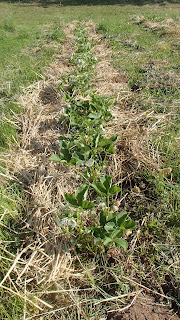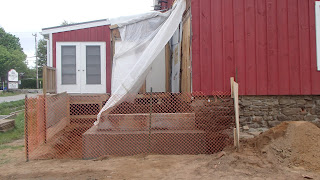To view the latest from Ridge Berry Farm visit our new blog and site!
With the "May 2 4" weekend officially behind us, it is now cottage season in Ontario and, as the unofficial start of the summer, it is time for some serious gardening.
For us at the farm, it's been a time of pruning our berry canes... under what has been a very hot mid-day sun. It's also been time to tackle our strawberry beds. And on this front, we're starting to learn a few things from past mistakes.
When we first arrived at the farm, we planted a couple of strawberry plants...just for fun. These now fill an entire bed. To control weeds we have been using straw mulch.
Last year, we decided to expand our strawberry production by planting a few rows. Although we have made strawberry jam and pies for the Tea Room using local berries, the idea was to finally produce enough ourselves for this purpose. The results look very promising this year, many plants are in full bloom and some are already showing signs of green berries.
 |
| The Strawberry crop is looking promising |
However we've also made some terrible mistakes. First, we were not very liberal with our straw mulch. Second, we planted Strawberry rows and left grass in between. Since we do not use any chemical fertilizer, herbicide or pesticide, the result this Spring is a bit of a mess. Weeds have taken over our Strawberries in a big way.
 |
| Strawberry rows....a mess of grass and weeds |
Now we have a major effort on our hands clearing each row individually and by hand. The hard fought campaign against weeds is finally showing some promise.
 |
| Things look a lot better when cleared up. |
We've decided to never let this happen again. In fact, not only will we be more liberal with our mulch, but we've decided to cover the entire Strawberry patch with straw later this season. After all, the grass in between is a waste of labor and energy (mowing) and could be used to increase our yield per square meter.
On the other hand we have discovered something interesting in our old Strawberry bed: a new weed. We call it "new" because we've never really had to identify it. It turns out, it's called Purple Deadnettle. Related to the nettle, it is called "dead nettle" because it does not sting.
The reason this weed caught our attention is that it seems to grow well with the Strawberries, while keeping other weeds at bay. Its small flowers also seem to attract pollinating insects just as the Strawberries need them. The Strawberries grow tall and bloom well among the Purple Deadnettle and the bed requires no weeding!
 |
| Strawberries blooming among Purple Deadnettle in our old Strawberrry bed |
Thinking we may have struck on a great permaculture solution we actually looked this up on the Internet and the first hit was a bit a surprise. A forager had blogged about a Purple Deadnettle and Strawberry salad!
It turns out that Purple Deadnettle is edible and like its distant cousin, the Stinging Nettle, is a healthy food. We had to try it. The taste is nothing to write home about, but it is fascinating to see these two plants (the making of a salad) working so well together.
The result is that we are no longer weeding the Purple Deadnettle whenever we see it near our Strawberries. We hope to see what this will do next year. The problem is that the Purple Deadnettle is an annual that is obviously self-seeding. Hopefully the seeds do not travel too far.
Elsewhere, at the Tea Room, work has now started on some new bathrooms. Foundations have been poured. This does not affect our operations, but we ask our patrons for their understanding as the back of the barn looks a bit like a work zone.
 |
| Work on new Tea Room bathrooms has now started. |
We'd like to add that now that summer is unofficially started the Tea Room is getting rather busy and a lot of functions have been booked. This is particularly the case on weekends. As a result, we now highly recommend reservations (we hate to have to turn away regular and prospective patrons).
If you've not been to the Tea Room recently, we'd like to add that the market also has a new look and expanded offerings. Seating is available for basic tea service and along with berries (seasonally), jams, chutneys, and syrups, gift items are also available. This includes art work (from our own in house artist), clothing, and vintage jewelry.


We'll close this blog entry with one quick announcement. The Tea Room will be hosting an event on the evening of June 7th. SlowFood Niagara is hosting its first evening open to the public. Tickets are $15/person. Food will be provided by the SlowFood convivium (this includes our Tea Room finger sandwiches) and a talk will be provided by Anna Valli of
The Valli Girls meat shop in Ste. Catherine's (our source of drug-free, hormone-free meats). Should you be interested, please call us at 289-897-8943 to reserve a seat. Wine will also be available at additional cost.
